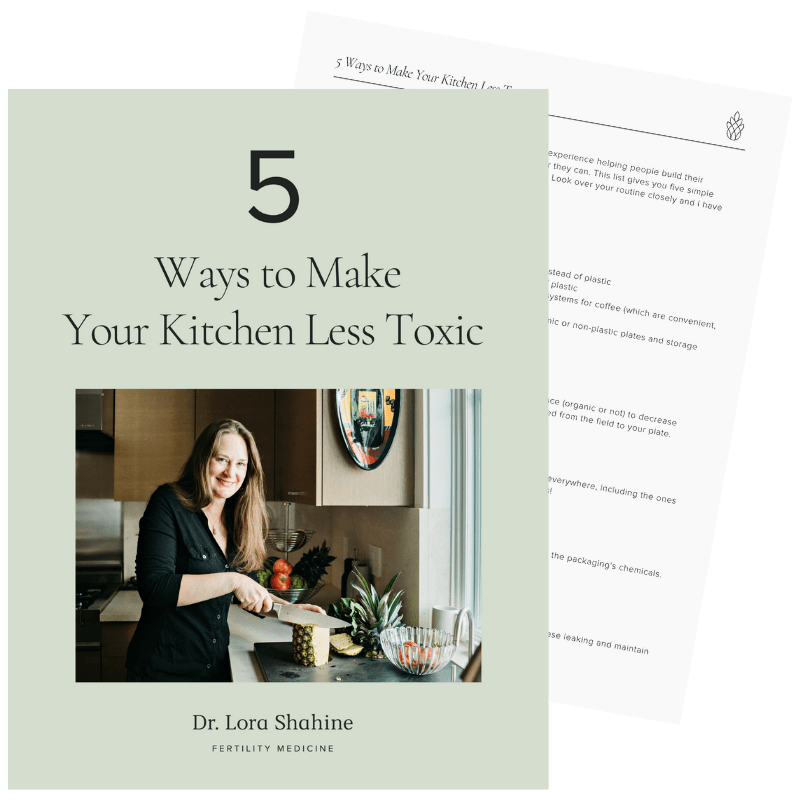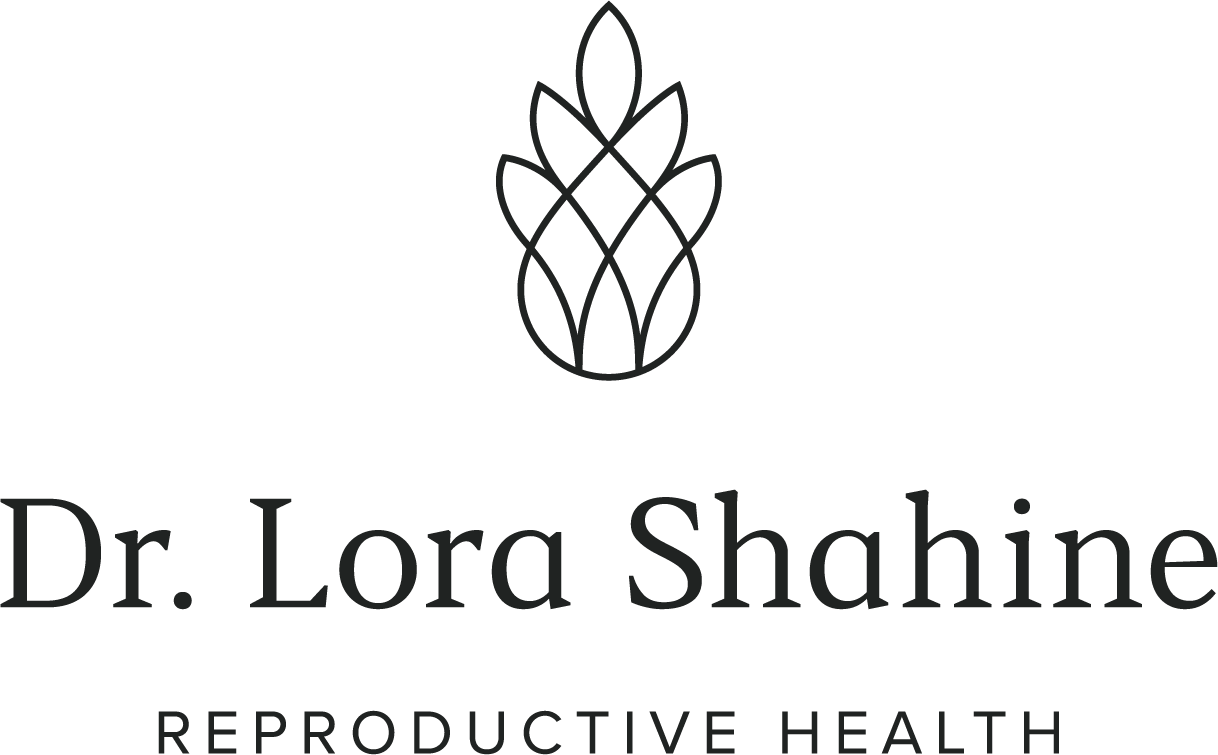
Resources for Fertility
First things first, you’re in a safe space.
My fertility content is well-researched and evidence-based, but it’s also open-minded and compassionate. I’ve been a reproductive endocrinologist and OBGYN for over 15 years, and I’ve realized that fertility’s mental and emotional considerations can be as important as the protocols we do or the medications we choose.

Featured video:
Does Stress Cause Infertility?
In this video, I cover the intricacies of diagnosing stress as an infertility cause, the connection between body and mind, the emotional experience of trying to build a family, and some of my favorite support communities for patients. For anyone who's looking to develop stress management toolkit, exercise mindfulness, and lower cortisol levels, this video is a must-watch.
Newest posts:
For Erica Loring, the journey to managing her chronic reproductive health issues has been a long and arduous one.
From a young age, she experienced debilitating menstrual symptoms that went far beyond the "normal" period pain many women endure. "I had really terrible endometriosis and I didn't know that obviously from the very jump of periods," Erica shares. "I suffered with all the things. I've had fibroids, I've had cysts, I have polyps, I've had endometriosis, I've had extreme bleeding."
The holiday season is a time of joy, celebration, and togetherness for many. However, for those dealing with infertility and the pain of miscarriage, the holidays can be a minefield of emotional triggers and unwanted questions.
As Dr. Lora Shahine, a double board-certified OB/GYN and reproductive endocrinologist, explains, "On one side, you could be feeling joy and excited and love the holiday season and on the other side you can be really worried about some pretty negative emotions coming up because so many of the holidays are surrounding family, very children focused."
Are you a gay man or single man considering starting a family? Have you begun the process of searching for an egg donor or gestational surrogate, but feel overwhelmed and unsure of the next steps? If so, you're not alone. The path to parenthood for men can be complex, with a maze of fertility testing, legal contracts, and international laws to navigate.
In this comprehensive guide, we'll dive deep into the real-life experiences and expert insights of Richard Westoby, an IVF and surrogacy advocate, author, and host of the popular podcast IVF Daddies. Richard has been through the journey himself, and he's dedicated the last decade to helping others like you build their families.
Have you ever felt like your body and mind go through a dramatic shift in the second half of your menstrual cycle? You're not alone. The luteal phase, the time between ovulation and the start of your period, can bring a rollercoaster of physical and emotional changes for many women. But what's really going on, and is there anything we can do about it?
In this in-depth exploration, we'll dive into the fascinating science behind the luteal phase, uncover the evolutionary reasons for its existence, and discover practical strategies to help you feel your best throughout your entire cycle.
Infertility is a deeply personal and often isolating experience that affects couples in profound ways. While the physical and emotional toll is widely documented from the female perspective, the male experience is frequently overlooked.
In this powerful and vulnerable conversation, author Jared Walker shares his journey through years of uncertainty, loss, and hope - and how creative expression helped rebuild connection with his partner amidst the pain.
The headlines were bold and attention-grabbing: "Human Embryos Made from Skin Cells." This groundbreaking scientific discovery has the potential to revolutionize the field of reproductive medicine, offering new hope to those struggling with infertility. But what does this research really mean, and how close are we to seeing this technology become a reality?
In this in-depth exploration, we'll dive into the science behind this breakthrough, understand the ethical considerations, and explore the far-reaching implications for the future of fertility. Join us as we unpack this incredible development with the help of Dr. Paula Amato, the reproductive endocrinologist and researcher at the forefront of this cutting-edge work.
Hair loss can be a deeply distressing experience for many women. Whether it's the sudden shedding after childbirth, the gradual thinning at the crown, or the patchy bald spots, hair loss can shake one's confidence and sense of identity. But the good news is, there are ways to get to the root of the problem and take proactive steps towards healthier, fuller hair.
In this comprehensive guide, we dive deep into the science and solutions behind female hair loss. Joined by board-certified dermatologist and hair loss expert, Dr. Joyce Park, we uncover the common causes, identify the warning signs, and equip you with practical strategies to regain control of your hair health.
In a recent episode of the Brave and Curious podcast, Lisa opened up about this deeply personal journey, sharing how the unexpected DNA findings led her on a path of self-discovery, family reconciliation, and ultimately, the inspiration for her new film, One Big Happy Family.
As Lisa explained, the DNA test indicated that only 50% of her genetic makeup aligned with what she had been told her entire life - that she was 100% Ashkenazi Jewish. The other 50% revealed a completely different ancestry, one that included a grandfather who was the same age as her, living just miles away. "It was enough truth for me to be intrigued, but enough that I was like, 'Okay, this test is wrong. This can't be,'" Lisa recalled.
In today's digital age, information about fertility, egg freezing, and IVF is readily available at our fingertips. But with so much content online, it can be challenging to separate fact from fiction. What's the truth about success rates? Is IVF a guarantee for building a family? And how do you cut through the noise of clickbait headlines to make informed choices about your reproductive health?
In this in-depth blog post, we'll dive into these questions and more with the help of Dr. Lucky Sekhon, a renowned reproductive endocrinologist and fertility expert. Drawing from both scientific evidence and personal experience, Dr. Sekhon shares her insights on navigating the complex world of modern fertility care.
When it comes to fertility care, there is often a divide between Eastern and Western approaches. On one side, you have the ancient wisdom of traditional Chinese medicine, with its focus on holistic wellness, acupuncture, and herbal remedies.
On the other, you have the evidence-based treatments of modern reproductive endocrinology, including IVF, intrauterine insemination, and advanced testing.
My must-read picks:
For Erica Loring, the journey to managing her chronic reproductive health issues has been a long and arduous one.
From a young age, she experienced debilitating menstrual symptoms that went far beyond the "normal" period pain many women endure. "I had really terrible endometriosis and I didn't know that obviously from the very jump of periods," Erica shares. "I suffered with all the things. I've had fibroids, I've had cysts, I have polyps, I've had endometriosis, I've had extreme bleeding."
The holiday season is a time of joy, celebration, and togetherness for many. However, for those dealing with infertility and the pain of miscarriage, the holidays can be a minefield of emotional triggers and unwanted questions.
As Dr. Lora Shahine, a double board-certified OB/GYN and reproductive endocrinologist, explains, "On one side, you could be feeling joy and excited and love the holiday season and on the other side you can be really worried about some pretty negative emotions coming up because so many of the holidays are surrounding family, very children focused."
Are you a gay man or single man considering starting a family? Have you begun the process of searching for an egg donor or gestational surrogate, but feel overwhelmed and unsure of the next steps? If so, you're not alone. The path to parenthood for men can be complex, with a maze of fertility testing, legal contracts, and international laws to navigate.
In this comprehensive guide, we'll dive deep into the real-life experiences and expert insights of Richard Westoby, an IVF and surrogacy advocate, author, and host of the popular podcast IVF Daddies. Richard has been through the journey himself, and he's dedicated the last decade to helping others like you build their families.
Have you ever felt like your body and mind go through a dramatic shift in the second half of your menstrual cycle? You're not alone. The luteal phase, the time between ovulation and the start of your period, can bring a rollercoaster of physical and emotional changes for many women. But what's really going on, and is there anything we can do about it?
In this in-depth exploration, we'll dive into the fascinating science behind the luteal phase, uncover the evolutionary reasons for its existence, and discover practical strategies to help you feel your best throughout your entire cycle.
Infertility is a deeply personal and often isolating experience that affects couples in profound ways. While the physical and emotional toll is widely documented from the female perspective, the male experience is frequently overlooked.
In this powerful and vulnerable conversation, author Jared Walker shares his journey through years of uncertainty, loss, and hope - and how creative expression helped rebuild connection with his partner amidst the pain.
The headlines were bold and attention-grabbing: "Human Embryos Made from Skin Cells." This groundbreaking scientific discovery has the potential to revolutionize the field of reproductive medicine, offering new hope to those struggling with infertility. But what does this research really mean, and how close are we to seeing this technology become a reality?
In this in-depth exploration, we'll dive into the science behind this breakthrough, understand the ethical considerations, and explore the far-reaching implications for the future of fertility. Join us as we unpack this incredible development with the help of Dr. Paula Amato, the reproductive endocrinologist and researcher at the forefront of this cutting-edge work.
Hair loss can be a deeply distressing experience for many women. Whether it's the sudden shedding after childbirth, the gradual thinning at the crown, or the patchy bald spots, hair loss can shake one's confidence and sense of identity. But the good news is, there are ways to get to the root of the problem and take proactive steps towards healthier, fuller hair.
In this comprehensive guide, we dive deep into the science and solutions behind female hair loss. Joined by board-certified dermatologist and hair loss expert, Dr. Joyce Park, we uncover the common causes, identify the warning signs, and equip you with practical strategies to regain control of your hair health.
In a recent episode of the Brave and Curious podcast, Lisa opened up about this deeply personal journey, sharing how the unexpected DNA findings led her on a path of self-discovery, family reconciliation, and ultimately, the inspiration for her new film, One Big Happy Family.
As Lisa explained, the DNA test indicated that only 50% of her genetic makeup aligned with what she had been told her entire life - that she was 100% Ashkenazi Jewish. The other 50% revealed a completely different ancestry, one that included a grandfather who was the same age as her, living just miles away. "It was enough truth for me to be intrigued, but enough that I was like, 'Okay, this test is wrong. This can't be,'" Lisa recalled.
In today's digital age, information about fertility, egg freezing, and IVF is readily available at our fingertips. But with so much content online, it can be challenging to separate fact from fiction. What's the truth about success rates? Is IVF a guarantee for building a family? And how do you cut through the noise of clickbait headlines to make informed choices about your reproductive health?
In this in-depth blog post, we'll dive into these questions and more with the help of Dr. Lucky Sekhon, a renowned reproductive endocrinologist and fertility expert. Drawing from both scientific evidence and personal experience, Dr. Sekhon shares her insights on navigating the complex world of modern fertility care.
When it comes to fertility care, there is often a divide between Eastern and Western approaches. On one side, you have the ancient wisdom of traditional Chinese medicine, with its focus on holistic wellness, acupuncture, and herbal remedies.
On the other, you have the evidence-based treatments of modern reproductive endocrinology, including IVF, intrauterine insemination, and advanced testing.
Fertility content on TikTok:
@drlorashahine I loathe the word ‘JUST’ #infertility #ttc #miscarriage #fertilitydoctor
♬ original sound - Lora Shahine, MD
@drlorashahine Easy to get confused - here to help! #fertility #infertility #ivf #ovulation
♬ original sound - Lora Shahine, MD
@drlorashahine First in a series - let me know what you want to learn about! #fertility #women #ttc #fertilitytips
♬ Fertility Tips Ovulation Edition - Lora Shahine, MD
Fertility content on Instagram:
Popular posts:
For Erica Loring, the journey to managing her chronic reproductive health issues has been a long and arduous one.
From a young age, she experienced debilitating menstrual symptoms that went far beyond the "normal" period pain many women endure. "I had really terrible endometriosis and I didn't know that obviously from the very jump of periods," Erica shares. "I suffered with all the things. I've had fibroids, I've had cysts, I have polyps, I've had endometriosis, I've had extreme bleeding."
The holiday season is a time of joy, celebration, and togetherness for many. However, for those dealing with infertility and the pain of miscarriage, the holidays can be a minefield of emotional triggers and unwanted questions.
As Dr. Lora Shahine, a double board-certified OB/GYN and reproductive endocrinologist, explains, "On one side, you could be feeling joy and excited and love the holiday season and on the other side you can be really worried about some pretty negative emotions coming up because so many of the holidays are surrounding family, very children focused."
Are you a gay man or single man considering starting a family? Have you begun the process of searching for an egg donor or gestational surrogate, but feel overwhelmed and unsure of the next steps? If so, you're not alone. The path to parenthood for men can be complex, with a maze of fertility testing, legal contracts, and international laws to navigate.
In this comprehensive guide, we'll dive deep into the real-life experiences and expert insights of Richard Westoby, an IVF and surrogacy advocate, author, and host of the popular podcast IVF Daddies. Richard has been through the journey himself, and he's dedicated the last decade to helping others like you build their families.
Have you ever felt like your body and mind go through a dramatic shift in the second half of your menstrual cycle? You're not alone. The luteal phase, the time between ovulation and the start of your period, can bring a rollercoaster of physical and emotional changes for many women. But what's really going on, and is there anything we can do about it?
In this in-depth exploration, we'll dive into the fascinating science behind the luteal phase, uncover the evolutionary reasons for its existence, and discover practical strategies to help you feel your best throughout your entire cycle.
Infertility is a deeply personal and often isolating experience that affects couples in profound ways. While the physical and emotional toll is widely documented from the female perspective, the male experience is frequently overlooked.
In this powerful and vulnerable conversation, author Jared Walker shares his journey through years of uncertainty, loss, and hope - and how creative expression helped rebuild connection with his partner amidst the pain.
The headlines were bold and attention-grabbing: "Human Embryos Made from Skin Cells." This groundbreaking scientific discovery has the potential to revolutionize the field of reproductive medicine, offering new hope to those struggling with infertility. But what does this research really mean, and how close are we to seeing this technology become a reality?
In this in-depth exploration, we'll dive into the science behind this breakthrough, understand the ethical considerations, and explore the far-reaching implications for the future of fertility. Join us as we unpack this incredible development with the help of Dr. Paula Amato, the reproductive endocrinologist and researcher at the forefront of this cutting-edge work.
Hair loss can be a deeply distressing experience for many women. Whether it's the sudden shedding after childbirth, the gradual thinning at the crown, or the patchy bald spots, hair loss can shake one's confidence and sense of identity. But the good news is, there are ways to get to the root of the problem and take proactive steps towards healthier, fuller hair.
In this comprehensive guide, we dive deep into the science and solutions behind female hair loss. Joined by board-certified dermatologist and hair loss expert, Dr. Joyce Park, we uncover the common causes, identify the warning signs, and equip you with practical strategies to regain control of your hair health.
In a recent episode of the Brave and Curious podcast, Lisa opened up about this deeply personal journey, sharing how the unexpected DNA findings led her on a path of self-discovery, family reconciliation, and ultimately, the inspiration for her new film, One Big Happy Family.
As Lisa explained, the DNA test indicated that only 50% of her genetic makeup aligned with what she had been told her entire life - that she was 100% Ashkenazi Jewish. The other 50% revealed a completely different ancestry, one that included a grandfather who was the same age as her, living just miles away. "It was enough truth for me to be intrigued, but enough that I was like, 'Okay, this test is wrong. This can't be,'" Lisa recalled.
In today's digital age, information about fertility, egg freezing, and IVF is readily available at our fingertips. But with so much content online, it can be challenging to separate fact from fiction. What's the truth about success rates? Is IVF a guarantee for building a family? And how do you cut through the noise of clickbait headlines to make informed choices about your reproductive health?
In this in-depth blog post, we'll dive into these questions and more with the help of Dr. Lucky Sekhon, a renowned reproductive endocrinologist and fertility expert. Drawing from both scientific evidence and personal experience, Dr. Sekhon shares her insights on navigating the complex world of modern fertility care.
When it comes to fertility care, there is often a divide between Eastern and Western approaches. On one side, you have the ancient wisdom of traditional Chinese medicine, with its focus on holistic wellness, acupuncture, and herbal remedies.
On the other, you have the evidence-based treatments of modern reproductive endocrinology, including IVF, intrauterine insemination, and advanced testing.
Join my supportive, passionate, and connected community of 350k+.
My social media channels are my platform for infertility and miscarriage education. I find joy in educating with these creative outlets and look forward to connecting with you there.
Find peace of mind with my free guide to easily decrease toxins exposure.
















